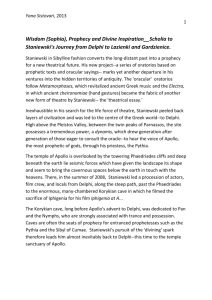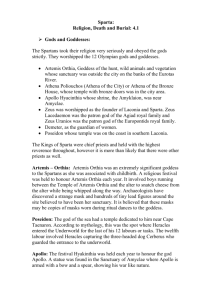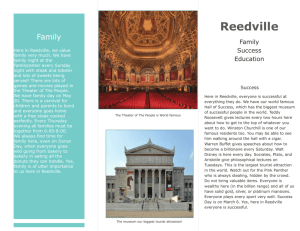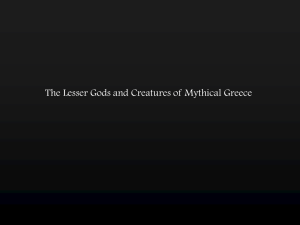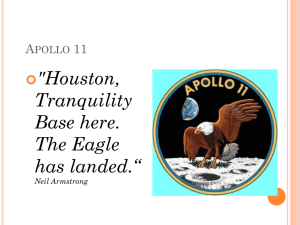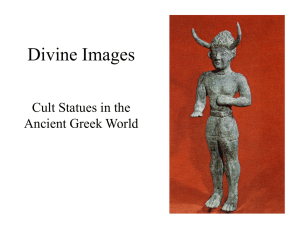THE APOLLO TEMPLE DELPHI GREECE The Apollo temple in
advertisement
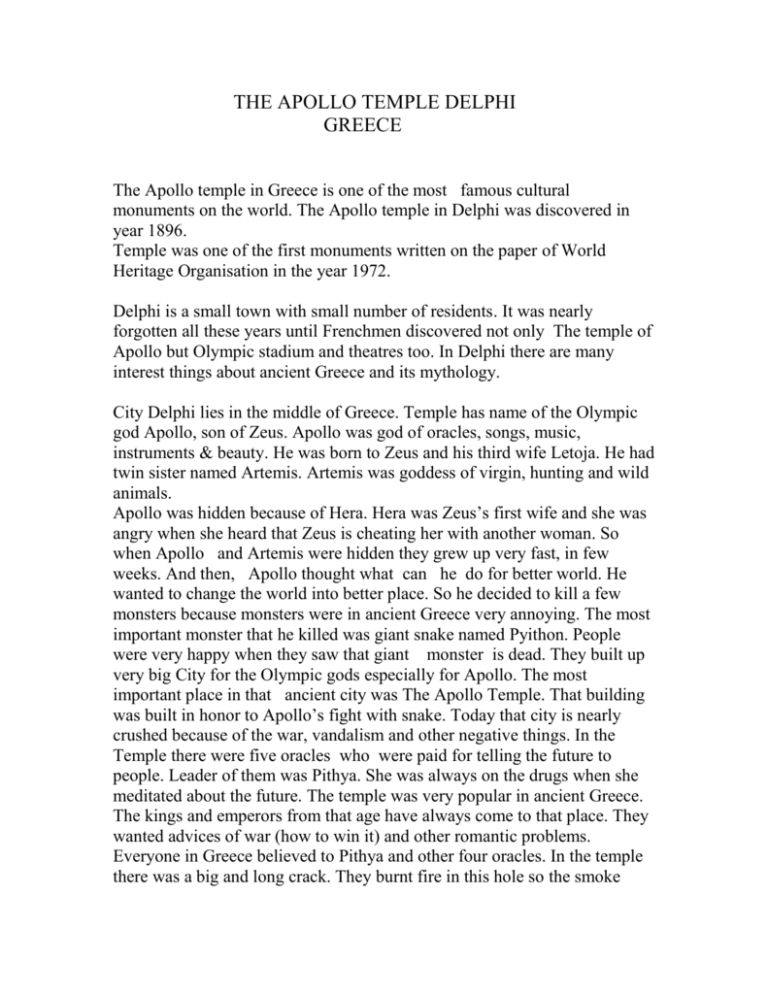
THE APOLLO TEMPLE DELPHI GREECE The Apollo temple in Greece is one of the most famous cultural monuments on the world. The Apollo temple in Delphi was discovered in year 1896. Temple was one of the first monuments written on the paper of World Heritage Organisation in the year 1972. Delphi is a small town with small number of residents. It was nearly forgotten all these years until Frenchmen discovered not only The temple of Apollo but Olympic stadium and theatres too. In Delphi there are many interest things about ancient Greece and its mythology. City Delphi lies in the middle of Greece. Temple has name of the Olympic god Apollo, son of Zeus. Apollo was god of oracles, songs, music, instruments & beauty. He was born to Zeus and his third wife Letoja. He had twin sister named Artemis. Artemis was goddess of virgin, hunting and wild animals. Apollo was hidden because of Hera. Hera was Zeus’s first wife and she was angry when she heard that Zeus is cheating her with another woman. So when Apollo and Artemis were hidden they grew up very fast, in few weeks. And then, Apollo thought what can he do for better world. He wanted to change the world into better place. So he decided to kill a few monsters because monsters were in ancient Greece very annoying. The most important monster that he killed was giant snake named Pyithon. People were very happy when they saw that giant monster is dead. They built up very big City for the Olympic gods especially for Apollo. The most important place in that ancient city was The Apollo Temple. That building was built in honor to Apollo’s fight with snake. Today that city is nearly crushed because of the war, vandalism and other negative things. In the Temple there were five oracles who were paid for telling the future to people. Leader of them was Pithya. She was always on the drugs when she meditated about the future. The temple was very popular in ancient Greece. The kings and emperors from that age have always come to that place. They wanted advices of war (how to win it) and other romantic problems. Everyone in Greece believed to Pithya and other four oracles. In the temple there was a big and long crack. They burnt fire in this hole so the smoke came out trough crack. They put many kinds of herbs in crack on fire so the smoke was colouros. Oracles watched the smoke and then they decided what does that mean and then they told the customer about the future. The Apollo temple was destroyed in the war perhaps when Romans attacked Greece. Today, Apollo temple is completely destroyed and just few statues left are standing on the place where 2500 years before there was a giant building one of the most beautiful of the world. Other buildings As I said there were some other buildings in Delphi but they were not so important as the temple of Apollo. Olympic stadium was constructed 500 B.C. It was a place where there were Olympic games. Every year people had competitions in many disciplines. The winners were very popular and respectable because people thought that gods like them because they won the game. And if gods like some persons other people must not hurt them anyway. Winners were drawn on the vases, goblets, cups and other stuff. They were not forgotten more than 500 years after their death. In Delphi there was a Gymnasium too. It was one of the best schools in ancient Greece. But that school was not made for peasants’ sons but for king’ s kids. It had two areas. One was Thermae (polls and baths). The second was athletic place where there The Treasury of the Athenians. Small building in Doric order, with two columns in antis, and rich relief decoration. It was built by the Athenians at the end of the 6th century B.C. in order to house their offerings to Apollo. After its restoration, in 1903-1906, it is the best preserved building on the site. The Theatre of the sanctuary. It was originally built in the 4th century B.C. but the ruins we see today date from the Roman Imperial period. The cavea had 35 rows of stone benches; the foundations of the skene are preserved on the paved orchestra. The theatre was used mostly for the theatrical performances during the great festivals of the sanctuary. The Tholos. Circular building in Doric order, built in 380 B.C. Its function remains unknown but it must have been an important building, judging from the multi-coloured stone, the fine workmanship and the high-standard relief decoration. Archaeological museum of Delphi The first museum of Delphi was built in 1903 on the plans of the French architect Tournaire and was later incorporated in a larger edifice, constructed in 1938. The rearrangement of the exhibition was carried out gradually and was finally completed in 1980. In 1974, a new room was added for the exhibition of the gold and ivory finds from the sanctuary. The museum is actually an integral part of the sanctuary and contains exclusively finds from the site of Delphi, mostly offerings and architectural parts. In the museum there are many interest items. These items were found Dephi by archaeologists. I will describe just few of them, the most popular ones. The Charioteer. Bronze statue of a charioteer, originally belonging to a larger group which represented a chariot drawn by four horses. It was dedicated to Apollo by Polyzalos, the tyrant of Gela, in 478 B.C. when he won the chariot-race at the Pythian Games. This incomparable statue is a representative example of the ''severe'' Attic style, certainly the work of a major artist. The frieze from the Treasury of the Siphnians decorated with relief representations of mythological scenes. On the north side, which is the finest and best preserved, there is a representation of Gigantomachy, the war of the gods of Olympus against the Giants. It is a wonderful specimen of the mature Archaic art, dated to 525 B.C. White-ground kylix decorated with a unique representation of Apollo. The god is seated on a stool, holds his lyre in his left hand and with his right pours the libation from a bowl. It is the work of an unknown skilled painter, dated to 480-470 B.C. These buildings which I described are the best memory on the ancient Greece and its very interesting mithology

